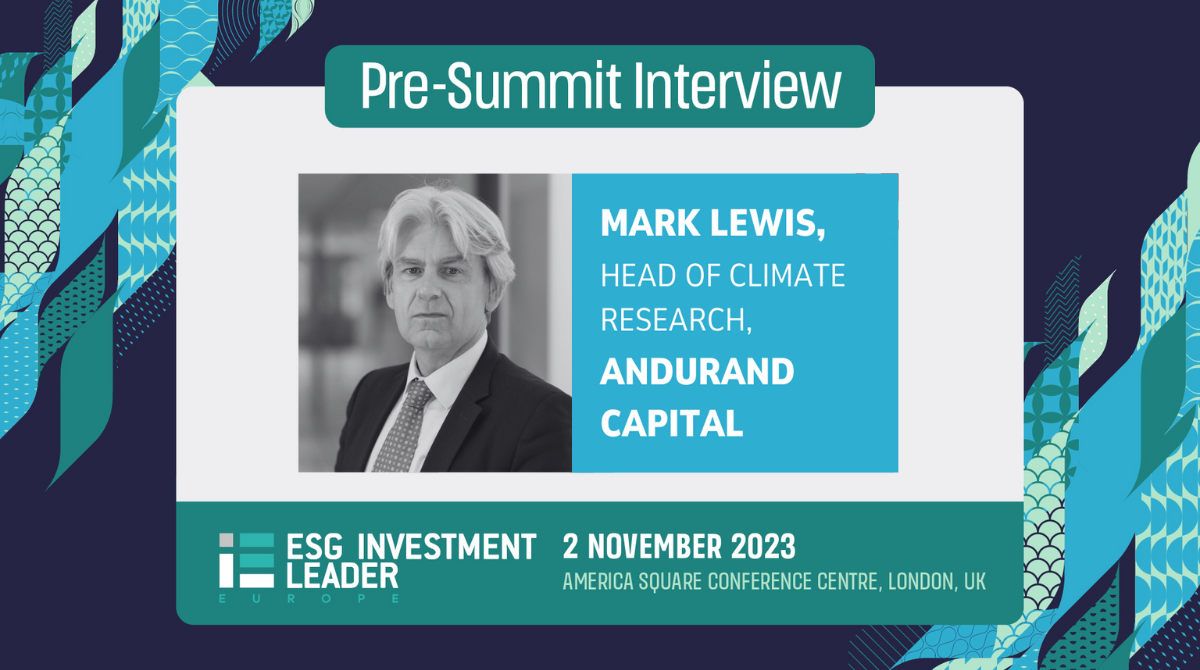 Mark Lewis, Head of Climate Research at Andurand Capital.
Mark Lewis, Head of Climate Research at Andurand Capital.
Maya Sibul: As we know, to keep promises made in the Paris Agreement, greenhouse gas emissions must be reduced by 45% by 2030 – and reach net zero by 2050. The UK has also committed to achieving net zero by 2050, as has the EU. The reality is a bit stickier. Given the difficulty of matching investments to these goals, which asset classes are most attractive now and in the future?
Mark Lewis: There are many asset classes that potentially fall into that bucket – so I would break it down into three segments.
First, equities – which means looking at the kinds of companies that are either helping to mitigate greenhouse gas emissions or are providing emissions in the form of adaptation.
On the mitigation side, it's well understood what we need to do – with 80% of global greenhouse gas emissions coming from energy combustion – get off fossil fuels and decarbonise the electricity industry. Renewable energy companies are one obvious, clear, winner from this global trend toward decarbonisation.
The second area I would highlight is commodities. For the energy transition, we need to dig deep into the energy sector, the electricity sector, and the transport sector; we need to electrify everything. That means the combination of electrification and other forms of clean fuels. Green hydrogen will play an important role too.
We also need to think about what metals we’ll need for the energy transition. We know what they are: copper, cobalt, nickel, and lithium. These are becoming extremely important in the future. Now, we’re talking about lithium the way we talk about oil – because it’s going to be the lubricant and investors are starting to pay attention to the commodity dimension here.
"Carbon emissions allowances will be an important part of an investor's portfolio."
The third element – which is close to my heart – is carbon emission allowances.
These are carbon allowances in compliance schemes, first and foremost. The UK is in the process of aligning its emissions trading system with the net zero goal – and with the broader net zero targets. We will see more and more jurisdictions and countries putting forward cap-and-trade schemes soon.
Carbon emissions allowances will be an important part of an investor's portfolio. The voluntary market is undergoing a structural transformation, because of Article Six under the Paris Agreement.
That’s how I would think about an investment portfolio aligned with net zero goals.
Maya: How do you envision this net zero asset mix shifting as deadlines approach? You mentioned that there needs to be a greater focus on commodities, but – let’s say for something like renewable energy – how does the shift from emphasis on commodities to manufactured goods factor into the equation?
Mark: The key is in the question. Unfortunately, with the deadlines, there's only one scientific deadline that matters, namely the global net zero deadline of 2050.
However, as we all know, politics dictate headlines – which means they move at different speeds depending on the jurisdiction. If you’re talking about Europe, it’s fair to say they’re the furthest down the track, and we’ve seen a big structural shift in the pricing of carbon allowances.
If we were having this conversation three years ago, the situation would’ve been different; the price of carbon in Europe was then below €20 a tonne. We’re now trading at €88 a tonne – and we already hit €100 earlier this year. We probably need to see that price increase by the deadline by 35%. We would expect carbon prices in Europe to be anywhere between €150 and €200 a tonne by the time we get to 2030.
"As we move closer to the net zero imperative, to 2050, adaptation will take up a larger
and larger part of investor portfolios."
So, this is an obvious area that will attract more attention from investors. They should be aligning their portfolios with assets that will increase in value as we decarbonise – not those that will become subject to standard asset risk. Many traditional portfolios are still overexposed to carbon risk.
There will be a need for investors to align their equity holdings with companies that are doing more for both mitigation and adaptation, as I said earlier. Crucially, we talk about rolling deadlines and how investor attitudes will change as those deadlines approach. So far – both in terms of the political and financial imperative to decarbonise – the emphasis has overwhelmingly been on mitigation rather than adaptation.
But, as we’ve been reminded in an ugly way this summer by the wildfires in southern Europe, climate change is already here. It’s having a direct impact. We must think more about how we will adapt over time.
This means we’ll see interesting plays from companies around fire-resistant, energy-efficient buildings – or retrofitting. There’s a massive role for construction because buildings need heat, and the electricity they use is responsible for about 30% of greenhouse gas emissions. Then air conditioning is another can of worms.
As we move closer to the net zero imperative, to 2050, adaptation will take up a larger and larger part of investor portfolios.
Maya: So is carbon offsetting necessary – and how can we advance the discussion beyond ‘mitigation versus adaptation’? What are the opportunities and headaches here?
Mark: Offsetting has always been a controversial topic.
We make a very clear distinction between carbon allowances in cap-and-trade systems – which are designed to reduce carbon emissions over time (as seen in Europe, the UK, and California in the US) – and carbon offsets, which are generated from emissions reduction projects. Often, this means they’re against baselines, rather than ‘avoided’ emissions or absolute emissions reductions.
"Countries in the future will be able to issue Article 6 credits or offset
with a corresponding adjustment."
There are, of course, issues around that, but I think that, yes, offsets do have a role to play – at least until we’re able to produce all the energy we need free of fossil fuels. We need to compensate for the emissions we’re putting out there. Why would anyone object to greater amounts of reforestation and avoided deforestation?
The issue is that you need those credits to have integrity; you need permanence and additionality.
Another point relates to double counting. There’s been an important breakthrough – which I think will structurally change the nature of the voluntary market beyond all recognition. At COP26 in Glasgow, we saw the first agreement on Article 6. Countries in the future will be able to issue Article 6 credits or offset with a corresponding adjustment.
This means there can be inter-country transactions, as we’ve already seen. Switzerland can buy Article 6 credits from Peru, and then Peru loses the right to those credits. This can also be done with private companies. Peru, for example, could equally well be selling those credits to BP or Shell.
Under those circumstances, BP or Shell would have a credit compatible with the accounting framework of the Paris Agreement, which means that, in effect, you could then have a quasi-compliance credit. Why shouldn’t the EU or the UK – or any other jurisdiction that has a cap-and-trade scheme – allow these credits to be used at equal compliance value with their domestic emissions allowances?
These emissions reductions are being captured under the Paris framework, so if the EU were to allow them to be used in the future, then you’re in no way undermining the integrity of the Paris Agreement.
In short, this is what I think will happen over time. Offsets will be necessary for a while, but they need to have integrity.
The best offsets you will be able to purchase in the future will be Article 6 credits with a corresponding adjustment – and I believe that those credits should ultimately be allowed for use at equal compliance value in compliance trading schemes.
Maya: How are shifting regulatory landscapes – between the UK, EU, US, and Asia, let’s say – impacting attractive investments for global organisations? How can investment teams account for these differences in their investment strategies?
Mark: We live in a global economy – though perhaps one that is beginning to slowly break some of the links we’ve seen develop over the last 30 years. Still, the global economy means that there’s always a fight for global capital, with different jurisdictions always looking to attract investment to their respective regions.
The real game changer is the United States’s Inflation Reduction Act (IRA), which is all about driving the clean energy transition in the US. The IRA is undoubtedly the most comprehensive climate legislation we’ve seen from the US.
The fact that it’s called the IRA doesn’t deceive anyone in terms of what its real motivation is. Really, it’s full of attractive incentives for people who want to develop clean energy, green energy, green hydrogen; you name it.
The other thing that’s changed the global geopolitical landscape in terms of the fight for global capital is Russia’s invasion of Ukraine. It’s reminded European policymakers that they are over-reliant on Russian fossil fuels – and that they need to speed up the transition to a clean economy.
"Europe needs to rise to the challenge and think of other ways to incentivise
investment and adoption."
So, there will be an ongoing fight for global investment in different regions. Some areas will have policies tailored to their individual needs, but the US has raised the bar by setting a challenge for Europe to match. In Europe – due to the nature of the EU – we see a more fragmented polity. So, it’s initially more difficult for Europe because you have to get an agreement between 27 member states.
But I think we should all be applauding the fact that the world’s largest economy is setting a standard. Other countries and regions around the world will need to keep up – which is a good thing. We need competition for green energy, to welcome it into the mix.
Europe needs to rise to the challenge and think of other ways to incentivise investment and adoption. It’s done a great job of being the leader thus far, but now is the time to step up and accelerate the green transition further.
Mark will be speaking at ESG Investment Leader | Europe 2023 in London on 2nd November. You can find more information, including how to register, here.
Please Sign In or Register to leave a Comment.
SUBSCRIBE
Get the recent popular stories straight into your inbox




